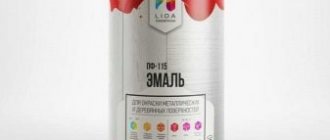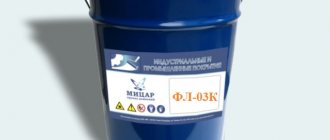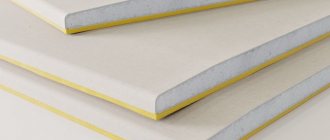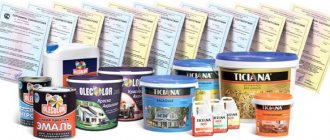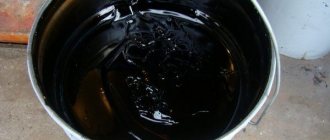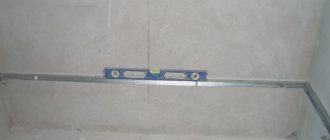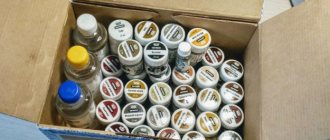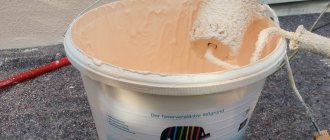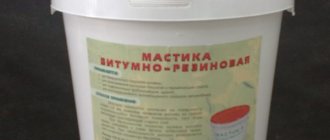Water-dispersive acrylic putty is currently one of the most popular types of this line of materials.
This type of construction raw material appeared in Russia not so long ago, but has managed to prove itself due to its performance qualities.
It is perfect for leveling walls and ceilings, eliminating defects such as cracks, crevices, holes that need to be eliminated. This putty is used for work both indoors and outdoors.
Self-tinting
Stores sell a large variety of products for tinting building materials , including pigment primer for surface impregnation.
In order not to spend financial resources on the purchase of such compositions, it is recommended to do the tinting yourself, especially since it is simple. To select the correct tone, you need to apply a layer of acrylic paint on the dried primer. Thus, if the color does not suit you, then you can turn to a color scheme of a different shade.
What is it used for?
Many novice builders do not attach much importance to the primer underneath the decorative surface.
defects appear on the surface where a layer of plaster or wallpaper was applied :
- wrinkled surface;
- the appearance of cracks on the surface;
- swelling of the coating.
If you use an acrylic primer, then you can appreciate its protection against surface distortion. The composition after application forms a dense film, and there is improved adhesion and protection for the top layer of enamel. This improves the surface gloss.
Another feature that forces the use of such coatings is that the wall after the soil mixture becomes resistant to liquids getting on it.
The important point is that almost all types of soil mixtures can be applied to any surface.
Mixtures vary in composition : they can be produced on a water basis or on organic solvents.
Those mixtures that are produced with organic solvents are most suitable for external surfaces, which can sometimes be exposed to precipitation .
For interior work, it is recommended to choose water-based acrylic primers. They lay smoothly and in terms of environmental components are much higher than those soils that are used in external work. In addition, they do not have an unpleasant odor or emit harmful fumes.
Application of primer
The primer will improve the adhesion of the mixture to the wall.
Before you start puttingty, the surface must be carefully prepared. In this case, we use a primer, as for any type of surface finishing, adhering to several rules.
If the surface is painted, before priming it must be thoroughly cleaned of the old layer, sanded to a matte color, and washed off with water and washing powder.
After this, we rinse everything with clean water, wait for it to dry completely and proceed to priming.
If the surface is painted with organic paint, then there is no need to prime it.
If the surface intended for filling is wooden, then a primer will not be needed, because The irreplaceable adhesion properties of our putty will come into play here.
If we have to work with a concrete surface or a plastered surface, then before priming, we need to wait a month from the moment of concrete construction or application of plaster.
Before priming, the entire surface must be cleaned of dust and dirt, where it is necessary to resort to sanding the surface. If there are formations of mold or fungi or there is a suspicion of their presence, we must carry out disinfection work, wash and dry these places.
After this we apply a primer. You can spray it with a spray bottle or apply it with a short-nap roller. The solution should not collect in one place and form smudges.
After the surface has dried, the application of the primer must be repeated again and wait at least 12 hours before starting to putty.
Advantages and disadvantages
The main advantage of such a primer is that it is absolutely harmless. Unlike products that contain chemical solvents, water-dispersion primer does not produce an unpleasant odor when used. However, the person doing the priming needs to be careful not to get the product in the eyes. When using this primer, windows and doors do not need to be opened.
The water-dispersion primer is easy to use and non-flammable. It is applied to wall surfaces using a roller or brush. Priming with this product is quick, even if you need to coat 2 layers.
There are almost no disadvantages to such a primer. A minor disadvantage is the need to store the product at a positive temperature. When frozen, the primer loses its properties.
The technical characteristics of the material also played a role in making the water-dispersion primer in demand among consumers.
The main technical characteristics of the material are:
- visually it is a homogeneous film with no pores or cracks;
- volatile substances – 20%;
- viscosity coefficient – 14 seconds;
- abrasion coefficient – 70 microns;
- film formation – 3.5 g/m²;
- drying within 14 hours.
When choosing a primer for repair work, give preference to a reliable and well-known manufacturer and brand. Also remember that a high-quality and certified product can be sold exclusively in specialized construction stores.
Safety and storage rules
Before starting coloring, apply protective cream to your face and hands and wear glasses. The room should be well ventilated during the painting process.
Water-dispersed acrylic paints must be stored at a temperature of 030°C. In the cold, storage of the material is allowed only for up to 1 month.
Choose paints from certified, trusted manufacturers; it is also worth checking with the seller the storage conditions of containers with the mixture, since improper storage often leads to a deterioration in the consistency of the material and its thickening. When choosing paint for a particular room, you need to rely on indicators such as temperature, humidity, light level, and the need for decorative effects.
Acrylic paint is the most popular among facade paints. And this is not surprising: it fits perfectly on any surface: concrete, wood, plastered,...
Paint is one of the most versatile and common materials for decorating various surfaces. The market is full of products for domestic and…
With the help of textured paint, your room will sparkle with new colors. In this article you will learn how to perform the dyeing process with this substance...
Indicators reflecting the consumer properties of VDLKM, and test methods
Table B.1
| Indicator name | Test method |
| 1 Covering power | According to GOST 8784 |
| 2 Dynamic viscosity | According to ND or TD for a specific material |
| 3 Adhesion | According to GOST 15140 |
| 4 Hardness according to a pendulum device | According to GOST 5233 |
| 5 Elasticity when bending | According to GOST 6806 |
| 6 Impact strength | According to GOST 4765 |
| 7 Conditional light fastness | According to GOST 21903 |
| 8 Shine | According to GOST 896 |
| 9 Density | According to GOST 28513 |
| 10 Fire hazard: | |
| film smoke coefficient | According to GOST 12.1.044 |
| toxicity indicator of film combustion products | According to GOST 12.1.044 |
| 11 Sandability | According to ND or TD for a specific material |
| 12 Penetration | According to GOST 5346 |
| Notes 1 The mandatory nature of the indicator is determined by the area of application of the product. 2 The indicator is determined only for materials intended for interior decoration of buildings. 3 Additional indicators not provided for in this appendix are indicated in the ND or TD for a specific brand of product depending on the area of application. | |
Choice of putty
Acrylic putty does not need to be diluted.
Water-dispersive putties are used to treat the following types of surfaces: concrete, brick, foam block, gas block, plaster, wood, painted surfaces, etc.
Acrylic putty is already ready for use; it does not need to be diluted like dry mixtures.
This makes it very convenient to use and differs from other types.
Not only a professional, but also an amateur builder can work with such putty.
When choosing a water-dispersive putty, it is important to pay attention to the following properties:
- First of all, you need to determine for what purpose the material will be used - facade, room. The type of putty in question has the property of being moisture resistant, so it is ideal for working in a room with high humidity, for example, in a bathroom.
After the putty has dried, the finishing coat can be applied. - We pay attention to the adhesion properties of the putty to the surface. The solution must have good adhesion. The result of the work (smooth finish, without cracks and pits) and the durability of the layer depend on it.
- The material must have low-flammability properties, not have a strong odor, be easy to apply, and dry quickly.
- For good quality putty there is no need to use reinforcement for additional adhesion to the surface.
In addition to acrylic-based putty, you can use material based on synthetic resins, which improve adhesion, drying of the layer and other properties of the putty.
In any case, water-dispersive putty has the following positive aspects: it protects against exposure to ultraviolet radiation, is resistant to deformation, has thermal insulation, vapor permeability, moisture resistance, tolerates winter well, and is environmentally friendly.
So, as we see, the advantages of this type of putty are undeniable. You just need to decide on the composition and pay attention to the type of surface being treated (facade, room, walls, ceiling).
After using the water-dispersive putty, you can apply paint or glue wallpaper. The surface looks very high quality, dignified, and holds up well for many years, decorating the room outside and inside.
The main thing is not to forget about the rules for storing the solution - in an airtight or tightly closed bucket. In this case, it will not spoil, will only bring benefits and will never disappoint.
